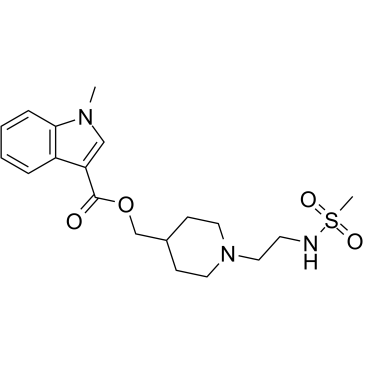GR113808

GR113808 structure
|
Common Name | GR113808 | ||
|---|---|---|---|---|
| CAS Number | 144625-51-4 | Molecular Weight | 393.50000 | |
| Density | 1.3g/cm3 | Boiling Point | 572.3ºC at 760 mmHg | |
| Molecular Formula | C19H27N3O4S | Melting Point | N/A | |
| MSDS | USA | Flash Point | 299.9ºC | |
|
Novel antagonists of serotonin-4 receptors: synthesis and biological evaluation of pyrrolothienopyrazines.
Bioorg. Med. Chem. 17 , 2607-2622, (2009) Based on the definition of a 5-HT(4) receptor antagonist pharmacophore, a series of pyrrolo[1,2-a]thieno[3,2-e] and pyrrolo[1,2-a]thieno[2,3-e] pyrazine derivatives were designed, prepared, and evaluated to determine the properties necessary for high-affinity... |
|
|
Dual role of serotonin in the pathogenesis of indomethacin-induced small intestinal ulceration: pro-ulcerogenic action via 5-HT3 receptors and anti-ulcerogenic action via 5-HT4 receptors.
Pharmacol. Res. 66(3) , 226-34, (2012) Serotonin (5-HT) exerts multiple physiological functions not only in the central and peripheral nervous systems but also in the gastrointestinal tract, and these multiple functions are accounted for by a variety of 5-HT receptor subtypes. We investigated the ... |
|
|
Molecular characterization of a purified 5-HT4 receptor: a structural basis for drug efficacy.
J. Biol. Chem. 280(21) , 20253-60, (2005) Serotonin 5-HT(4(a)) receptor, a G-protein-coupled receptor (GPCR), was produced as a functional isolated protein using Escherichia coli as an expression system. The isolated receptor was characterized at the molecular level by circular dichroism (CD) and ste... |
|
|
A 5-HT4 agonist, mosapride, enhances intrinsic rectorectal and rectoanal reflexes after removal of extrinsic nerves in guinea pigs.
Am. J. Physiol. Gastrointest. Liver Physiol. 289(2) , G351-60, (2005) Distension-evoked reflex of rectorectal (R-R) contractions and rectointernal anal sphincter (R-IAS) relaxations can be generated in guinea pigs through an extrinsic sacral excitatory neural pathway (pelvic nerves) as well as intrinsic cholinergic excitatory a... |
|
|
5-HT4 and 5-HT2 receptors antagonistically influence gap junctional coupling between rat auricular myocytes.
J. Mol. Cell. Cardiol. 48(1) , 220-9, (2010) 5-hydroxytryptamine-4 (5-HT(4)) receptors have been proposed to contribute to the generation of atrial fibrillation in human atrial myocytes, but it is unclear if these receptors are present in the hearts of small laboratory animals (e.g. rat). In this study,... |
|
|
Electrophysiological effects of prucalopride, a novel enterokinetic agent, on isolated atrial myocytes from patients treated with beta-adrenoceptor antagonists.
J. Pharmacol. Exp. Ther. 313(1) , 146-53, (2005) Prucalopride is a selective 5-hydroxytryptamine type 4 (5-HT4) receptor agonist developed for the treatment of gastrointestinal disorders. The endogenous agonist 5-HT acting via 5-HT4 receptors increases the L-type Ca2+ current (I(CaL)) with potentially proar... |
|
|
Secondary mechanical allodynia and hyperalgesia depend on descending facilitation mediated by spinal 5-HT₄, 5-HT₆ and 5-HT₇ receptors.
Neuroscience 222 , 379-91, (2012) In the present study we determined the role of spinal 5-hydroxytriptamine (5-HT) and 5-HT(4/6/7) receptors in the long-term secondary mechanical allodynia and hyperalgesia induced by formalin in the rat. Formalin produced acute nociceptive behaviors (flinchin... |
|
|
Effects of the selective serotonin reuptake inhibitor, fluoxetine, on regional gastric contractility.
Neurogastroenterol. Motil. 17(1) , 76-82, (2005) Selective serotonin reuptake inhibitors (SSRIs) are increasingly used to treat a variety of disorders but have gastrointestinal side-effects.To determine the effects of the SSRI, fluoxetine, on gastric smooth muscle contractility.Fundic, antral, and pyloric c... |
|
|
A 5-HT(4)-receptor activation-induced neural plasticity enhances in vivo reconstructs of enteric nerve circuit insult.
Neurogastroenterol. Motil. 22(7) , 806-13, e226, (2010) It was recently reported that some 5-HT(4)-receptor agonists increased neuronal numbers and length of neurites in enteric neurons developing in vitro from immunoselected neural crest-derived precursors. We aimed to explore a novel approach in vivo to reconstr... |
|
|
Modulation of hippocampal excitability by 5-HT4 receptor agonists persists in a transgenic model of Alzheimer's disease.
Neuroscience 129(1) , 49-54, (2004) 5-HT(4) receptors are widely distributed in both peripheral and central nervous systems where they couple, via a G-protein, to the activation of adenylate cyclase. In the brain, the highest 5-HT(4) receptor densities are found in the limbic system, including ... |